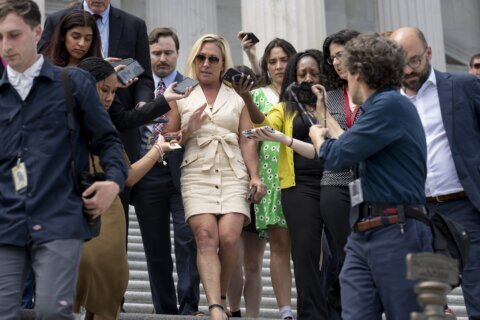WASHINGTON — A new report has been released by D.C’s. Homeland Security and Emergency Management Agency on the deadly smoke incident at L’Enfant Plaza Metro station on Jan. 12, 2015 .
It is the latest salvo in the back-and-forth between Metro, and D.C. Fire and EMS.
On Thursday, Metro concluded there was a problem with the radio settings at One Judiciary Square. This is where the radio control room is located for D.C. Fire and EMS communications. From there, cables take the signals to Gallery Place, then it is distributed to various stations in the Metro system.
On Jan. 8, D.C. Fire and EMS reported radio signal problems in the L’Enfant Plaza station in the 800Mhz range. Metro tried to find the cause, but says it didn’t find it until it discovered the settings changes on Jan. 14.
But Metro acknowledges that this would also mean that coverage on the encrypted radio channels, known as talk groups, would have been seriously compromised. Other sources tell WTOP that it would have meant no coverage inside any stations at all.
However, this report argues that encrypted radio channels did work at other stations.
“This report is a shot back at Metro and leaves us with more questions than answers. The two sides are telling contradictory stories,” says WTOP’s Sprawl and Crawl reporter, Ari Ashe.
D.C. Fire and EMS says it conducted tests on Dec. 8 at Benning Road, Stadium-Armory and Potomac Avenue.
“The tests showed the radios worked in the kiosks, platforms and tunnels in all three stations, with the exception of the Stadium-Armory tunnel areas where the transmission was intermittent,” the new report says.
This revelation, in addition to the Jan. 8 test results, appears to shift blame from One Judiciary Square to the L’Enfant Plaza tunnel.
D.C. Fire and EMS does not specify why it thinks there was sporadic communication in the tunnel on Jan. 12, only to say that it has nothing to do with the encrypted radio system.
There are a few possible explanations that may involve repeaters and antennas inside the station.
But like the Metro version released earlier this week, this story also has some holes.
If there were communication problems with radio signals inside the tunnel, then why didn’t it affect Metro radios? Metro has already said it had contact with the Yellow Line train inside the tunnel and all other radios worked fine. It also does not explain why passengers were able to call 911 from their cell phones.
Both Metro radios and smartphones send digital information outward to communicate. Those signals appear to have worked fine, based on reports up to the present.
“The NTSB is the only impartial agency conducting a fact-based investigation into this matter. We continue to give our full cooperation to the NTSB, including providing scores of interviews, statements, inspections, more than 370 hours of surveillance video, and more than 4,000 pages of documents to date,” says Metro spokesman Dan Stessel.
“As the NTSB said on Sunday, ‘The DC Government’s report is only one part of the emergency response, and it will be examined with all the evidence in the context of the investigation,'” he adds.
Ultimately, the NTSB has to determine which statements are true, which statements are false and what really happened on Jan. 12.
Dave Statter, a former reporter who runs the fire service website Statter911, tells WTOP that the report is “very forward-thinking” report and that the District government has been “more transparent” in this issue.
Metro said last week that encryption caused the radio problems that firefighters were having in the tunnel talking to other firefighters and their commander, Statter says.
“This new report says that’s not the case and there are many radio experts that I have talked to that agree with the District of Columbia government on this and disagree with Metro,” he says adding, “There is still a great disagreement between Metro and the D.C. government on the impact or what caused the radios not to work in the tunnel.”
The problems that Metro has had with D.C. Fire and other fire departments in the region during emergencies have existed for many, many years, according to Statter.
“This is a problem that needs correcting overall. They need to get on the same page when these emergencies occur and especially before emergencies occur — to take preventative actions so they don’t have the problems that existed,” he suggests.
Follow @WTOP on Twitter and on the WTOP Facebook page.
© 2015 WTOP. All Rights Reserved.







